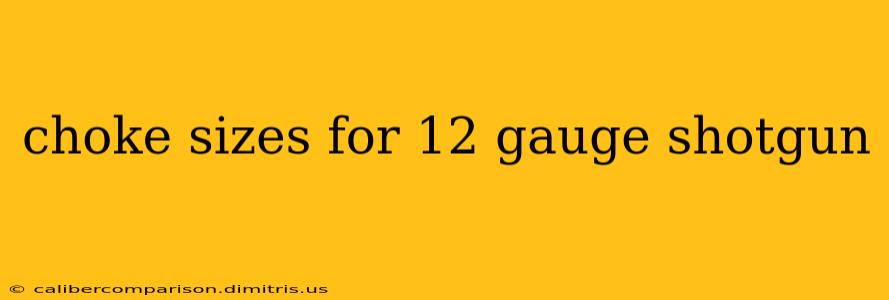Choosing the right choke for your 12-gauge shotgun is crucial for achieving optimal performance in various shooting scenarios. Understanding choke constrictions and their impact on shot patterns is key to improving your accuracy and overall shooting experience. This guide delves into the specifics of 12-gauge choke sizes, helping you select the best option for your needs.
Understanding Choke Constrictions
A shotgun choke is a device located at the muzzle of the barrel that modifies the shot pattern. It controls the spread of the shot pellets, influencing the density of the pattern at various distances. The tighter the choke, the narrower the shot pattern, resulting in greater range and accuracy but reduced overall pattern size. Conversely, a more open choke produces a wider, less dense pattern, ideal for close-range shooting.
Chokes are typically measured in terms of constriction, expressed as fractions of an inch or in millimeters. The constriction refers to the difference in diameter between the barrel's bore and the choke's narrowest point.
Common 12 Gauge Choke Sizes and Their Applications
Here's a breakdown of common 12-gauge choke sizes and their typical applications:
1. Cylinder Bore (CYL)
- Constriction: No constriction.
- Pattern: The widest shot pattern, ideal for very close-range shooting (e.g., within 20 yards) where a large spread is needed, such as hunting small, fast-moving game in thick cover. Not suitable for long-range shots.
2. Improved Cylinder (IC)
- Constriction: Slightly constricted.
- Pattern: A slightly tighter pattern than Cylinder Bore, suitable for closer-range shooting (up to 30 yards) than CYL. Offers a balance between pattern size and range. Often preferred for hunting birds at moderate ranges.
3. Modified (MOD)
- Constriction: Moderately constricted.
- Pattern: A more focused pattern than IC, extending effective range to around 35-40 yards. Ideal for hunting a variety of game, including upland birds and waterfowl. A good all-around choice.
4. Improved Modified (IMOD)
- Constriction: Tighter than Modified.
- Pattern: Offers a denser pattern with increased range and accuracy compared to Modified. Suitable for longer-range shots at waterfowl or clays.
5. Full (F)
- Constriction: The tightest constriction.
- Pattern: Produces the tightest and longest-range pattern, extending effective range to over 40 yards. Excellent for long-range waterfowl hunting or competitive shooting like trap and skeet. Can be less forgiving of slight aiming errors.
Choosing the Right Choke for Your Shooting Needs
The best choke size depends on several factors, including:
- Target/Game: The size and speed of your target will significantly influence your choke choice. Smaller, faster targets require a wider pattern, while larger, slower targets can benefit from a tighter choke.
- Range: Longer-range shooting requires tighter chokes for better accuracy, while closer-range shots can use more open chokes.
- Ammunition: The type of shot (e.g., lead, steel, bismuth) and shot size will also influence pattern density and spread.
Experimentation is key to finding the optimal choke for your specific needs and shooting style.
Beyond the Basics: Extended Range Chokes and More
The choke sizes discussed above represent the standard constrictions. You'll also find extended range chokes and specialized chokes (e.g., turkey chokes) designed for specific applications. Extended range chokes are often used for long-range shooting and can significantly extend effective range, while turkey chokes are designed to create exceptionally dense patterns for hunting turkeys at closer ranges.
This guide provides a foundation for understanding 12-gauge choke sizes. Remember to consult your shotgun's manual for specific recommendations and always prioritize safe gun handling practices.

